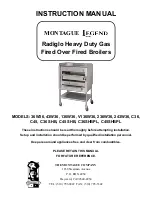
19
Additionally, if the gas valve has been adjusted, replaced, or the
appliance has been converted for use with another gas type,
then it becomes necessary to carry out a combustion analysis
check to ensure that correct combustion is occurring.
If there are no means to carry out a combustion analysis check,
then it will not be possible to complete the commissioning
procedure.
Details on how to carry out the combustion analysis can be
found in section 7.
IMPORTANT
It’s imperative that a sufficient dynamic – gas – pressure is
maintained at all times. Should the dynamic gas pressure fall
below an acceptable level, the appliance may malfunction or
sustain damage.
5.8 FINAL FLUSHING OF THE HEATING SYSTEM
The system shall be flushed in accordance with BS 7593 (I.S.
813 ROI). Should a cleanser be used, it must be suitable for
Aluminium heat exchangers. It shall be from a reputable manu-
facturer and shall be administered in strict accordance with the
manufacturers’ instructions and the DWTA code of practice.
NOTE
Chemicals used to cleanse the system and/or inhibit corrosion
must be pH neutral, i.e. they should ensure that the level of the
pH in the system water remains neutral. Premature failure of
certain components can occur if the level of pH in the system
water is out-with normal levels.
5.8.1 INHIBITORS
See Section 3 “General Requirements”.
5.9 SETTING THE FLOW OUTLET
TEMPERATURE
The flow outlet temperature can be adjusted between 40 °C -
80 °C for standard CH system by using the Heating thermostat
knob (see fig.1).
5.9.1 SETTING THE DHW OUTLET TEMPERATURE
The DHW outlet temperature can be adjusted between 37 °C
- 60 °C via the DHW thermostat knob (see fig.1).
5.10 SETTING THE SYSTEM DESIGN PRESSURE
The design pressure should be a minimum of 0.5 BAR and a
maximum of 1.5 BAR. The actual reading should ideally be 1
BAR plus the equivalent height in metres (0.1 BAR = 1 metre) to
the highest point in the system above the base of the appliance
(up to the maximum of 1.5 BAR total).
N.B.
The safety valve
is set to lift at 3 BAR/30 metres/45 psig. To lower the system
pressure to the required value, drain off some water from the
appliance drain valve until the required figure registers on the
pressure gauge (see fig. 1).
5.11 REGULATING THE CENTRAL HEATING
SYSTEM
Fully open all radiator and circuit valves and run the appliance
for both heating and hot water until heated water is circulating.
If conditions are warm remove any thermostatic heads. Adjust
radiator return valves and any branch circuit return valves
until the individual return temperatures are correct and are
approximately equal.
5.11.1 REGULATING THE DHW FLOW-RATE
The appliance is fitted with a flow rate restrictor that limits the
maximum flow rate that can be drawn through the appliance.
The restrictor eliminates the need to manually adjust the DHW
flow rate. However if it is felt necessary to further increase or
decrease the available flow rate, spare restrictors are available
to Vokèra spare parts.
The spare flow rate restrictors can be fitted to either increase
or decrease the maximum flow rate.
5.11.2 FLOW-RATE RESTRICTOR
The boiler is supplied with the following flow restrictor:
Compact 25A:
8 - litres flow restrictor
Compact 29A:
10 - litres flow restrictor
Compact 32A:
11 - litres flow restrictor
5.12 FINAL CHECKS
• ENSURE ALL TEST NIPPLES ON THE APPLIANCE GAS
VALVE ARE TIGHT AND CHECKED FOR TIGHTNESS.
• ENSURE THE APPLIANCE FLUE SYSTEM IS FITTED
CORRECTLY AND IS PROPERLY SECURED.
• ENSURE ALL PIPE WORK IS RE-CHECKED FOR TIGHT-
NESS.
• RE-FIT APPLIANCE CASING.
• COMPLETE BENCHMARK CHECKLIST.
FOR UK ONLY
Complete details of the boiler, controls, installation and com-
missioning in the Benchmark checklist at the back of this
book. It is important that the Benchmark checklist is correctly
completed and handed to the user. Failure to install and com-
mission the appliance to the manufacturers instructions will
invalidate the warranty.
5.13 INSTRUCTING THE USER
Hand over all documentation supplied with this appliance –
including these instructions – and explain the importance of
keeping them in a safe place.
Explain to the user how to isolate the appliance from the gas,
water and electricity supplies and the locations of all drain
points. Show the user how to operate the appliance and any
associated controls correctly.
Show the user the location of the filling valve and how to top-
up the system pressure correctly and show the location of all
manual air release points.
Explain to the user how to turn off the appliance for both long
and short periods and advise on the necessary precautions to
prevent frost damage.
Explain to the user that for continued safe and efficient operation,
the appliance must be serviced annually by a competent person.
IMPORTANT
To validate the appliance warranty, it’s necessary to register
the appliance details with us. The warranty can be registered
in several ways:
•
by completing the warranty registration card and posting to
us using the envelope supplied
•
online at: vokera.co.uk
•
for UK residents by calling: 0870 607 0281
•
for ROI residents by calling: 056 6655057.
















































